by Richard Peachey
In late 2011 and early 2012 my wife, Gerda, placed a series of business-card-size ads in the Coffee News. This is a cheery single-sheet weekly newspaper delivered to restaurants and coffee shops around our city of Abbotsford, British Columbia.
Each of her ads (which I prepared with her input) offered a brief quote from a famous person, for readers to think about. For the most part, we chose people who (as far as we know) hold to an evolutionary worldview. When you really listen to what they have to say, the creation account of the Bible begins to look better all the time!
Gerda’s ads are shown here along with a more detailed explanation. This article, consisting of ads plus explanations, has drawn many more hits on Gerda’s blogsite than any other item she has ever posted!
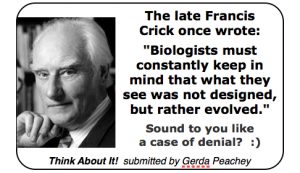 Nobel laureate Francis Crick is noted for his part (along with James Watson) in elucidating the structure of DNA. The fuller version of this quote shows Crick actually had reservations about putting too much stock in evolutionary explanations: “Biologists must constantly keep in mind that what they see was not designed, but rather evolved. It might be thought, therefore, that evolutionary arguments would play a large part in guiding biological research, but this is far from the case. It is difficult enough to study what is happening now. To try to figure out exactly what happened in evolution is even more difficult. Thus evolutionary arguments can usefully be used as hints to suggest possible lines of research, but it is highly dangerous to trust them too much. It is all too easy to make mistaken inferences unless the process involved is already very well understood.” (From Francis Crick’s autobiography What Mad Pursuit: A Personal View of Scientific Discovery. New York: Basic Books, 1988, pp. 138f.)
Nobel laureate Francis Crick is noted for his part (along with James Watson) in elucidating the structure of DNA. The fuller version of this quote shows Crick actually had reservations about putting too much stock in evolutionary explanations: “Biologists must constantly keep in mind that what they see was not designed, but rather evolved. It might be thought, therefore, that evolutionary arguments would play a large part in guiding biological research, but this is far from the case. It is difficult enough to study what is happening now. To try to figure out exactly what happened in evolution is even more difficult. Thus evolutionary arguments can usefully be used as hints to suggest possible lines of research, but it is highly dangerous to trust them too much. It is all too easy to make mistaken inferences unless the process involved is already very well understood.” (From Francis Crick’s autobiography What Mad Pursuit: A Personal View of Scientific Discovery. New York: Basic Books, 1988, pp. 138f.)
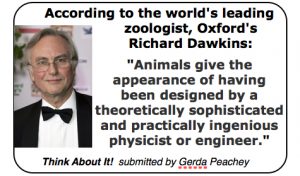 Oxford zoologist Richard Dawkins is the world’s leading spokesman for atheism and evolution. Nonetheless he frankly admits that living things do appear designed! The quotation is from Dawkins’ best-known book The Blind Watchmaker (New York: Norton, 1987), p. 36.
Oxford zoologist Richard Dawkins is the world’s leading spokesman for atheism and evolution. Nonetheless he frankly admits that living things do appear designed! The quotation is from Dawkins’ best-known book The Blind Watchmaker (New York: Norton, 1987), p. 36.
Though not by any stretch a creationist, Dawkins recognizes “good design” in the animal world, which is his area of expertise as a zoologist. Indeed, on page 1 of his book he offers this definition of life science: “Biology is the study of complicated things that give the appearance of having been designed for a purpose.”
And on page 15 he writes: “I want to follow [William] Paley [the intelligent design theorist of two centuries ago] in emphasizing the magnitude of the problem that our [evolutionist] explanation faces, the sheer hugeness of biological complexity and the beauty and elegance of biological design.”
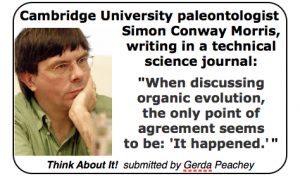
Simon Conway Morris, a paleontologist in the Department of Earth Sciences at Cambridge, makes a noteworthy statement about the shakiness of any particular “fact” of the evolutionary worldview.
Interestingly, this statement was published as the first sentence of the first article of the first issue of a very prestigious, perfumed secular science journal in the new millennium! (Cell 100:1, Jan. 7, 2000)

Software tycoon Bill Gates seems to understand that complex, coded information does not arise from random, chance, unguided, naturalistic events.
His comparison of DNA to a highly advanced computer program is quite apt. Molecular biologists can hardly restrain themselves from using terms that we normally associate with intelligence, such as “code,” “codon,” “machine,” “architecture,” “engineering,” and “elegant.”
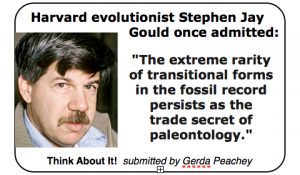 Until his death in 2002, Harvard paleontologist Stephen Jay Gould was North America’s leading spokesman for evolution. Gould is noted for his development (with Niles Eldredge) of the Punctuated Equilibrium theory of the fossil record. This proposal acknowledged the record’s serious problems (for evolutionists) of missing transitional intermediate forms, geologically “sudden appearance” of new forms, and long periods of “stasis” (no directional change).
Until his death in 2002, Harvard paleontologist Stephen Jay Gould was North America’s leading spokesman for evolution. Gould is noted for his development (with Niles Eldredge) of the Punctuated Equilibrium theory of the fossil record. This proposal acknowledged the record’s serious problems (for evolutionists) of missing transitional intermediate forms, geologically “sudden appearance” of new forms, and long periods of “stasis” (no directional change).
Immediately following the sentence in the Coffee News ad, Gould wrote: “The evolutionary trees that adorn our textbooks have data only at the tips and nodes of their branches; the rest is inference, however reasonable, not the evidence of the fossils. . . . The history of most fossil species includes two features particularly inconsistent with gradualism: 1. Stasis. Most species exhibit no directional change during their tenure on earth. They appear in the fossil record looking much the same as when they disappear; morphological change is usually limited and directionless. 2. Sudden appearance. In any local area, a species does not arise gradually by the steady transformations of its ancestors: it appears all at once and ‘fully formed.'” (“Evolution’s Erratic Pace.” Natural History 86[5]:14, May 1977.)

Right after the words shown in this ad, Paul Ehrlich (with coauthor L. C. Birch) went on to say: “It [i.e., our theory of evolution] is thus ‘outside of empirical science’ but not necessarily false. No one can think of ways in which to test it. Ideas, either without basis or based on a few laboratory experiments carried out in extremely simplified systems have attained currency far beyond their validity. They have become part of an evolutionary dogma accepted by most of us as part of our training.” (Nature 214:352, April 22, 1967)
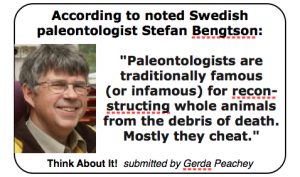 While at the Institute of Palaeontology, University of Uppsala (Sweden), Stefan Bengtson wrote an article that featured the words shown in the ad.
While at the Institute of Palaeontology, University of Uppsala (Sweden), Stefan Bengtson wrote an article that featured the words shown in the ad.
The next words in the article were: “Even extinct beasts such as dinosaurs have scores of living [alleged] relatives (birds, mammals, reptiles) that make reconstructions ‘simply’ a matter of competent comparative anatomy. But how do you go about the job when there seem to be no close living relatives on which to base the model? This is a problem particularly when dealing with organisms that derive from the ‘Cambrian explosion’. If any event in life’s history resembles man’s creation myths [so-called], it is this sudden diversification of marine life when multicellular organisms took over as the dominant actors in ecology and evolution. Baffling (and embarrassing) to Darwin, this event still dazzles us and stands as a major biological revolution on a par with the invention of self-replication [i.e., the origin of life!] and the origin of the eukaryotic cell.” (Nature 345:765, June 28, 1990)
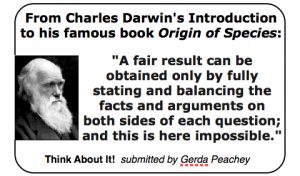
Charles Darwin is of course the father of modern evolutionary theory. His most famous book, first published in 1859, is the Origin of Species. The sixth edition (1872) is the one most often quoted. Just prior to the words shown in the ad, Darwin had said: “For I am well aware that scarcely a single point is discussed in this volume on which facts cannot be adduced, often apparently leading to conclusions directly opposite to those at which I have arrived.”
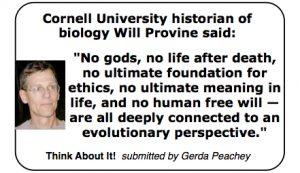 A noted atheist, Cornell University biology professor Will Provine has urged his fellow scientists to honestly face up to the existential implications of evolution. The quotation given here comes from Provine’s very chilling speech in the Ben Stein movie Expelled: No Intelligence Allowed.
A noted atheist, Cornell University biology professor Will Provine has urged his fellow scientists to honestly face up to the existential implications of evolution. The quotation given here comes from Provine’s very chilling speech in the Ben Stein movie Expelled: No Intelligence Allowed.
The fuller quotation is as follows: “No gods, no life after death, no ultimate foundation for ethics, no ultimate meaning in life, and no human free will — are all deeply connected to an evolutionary perspective. You’re here today and you’re gone tomorrow, and that’s all there is to it. . . . it starts by giving up an active deity, then it gives up the hope that there’s any life after death. When you give those two up, the rest of it follows fairly easily. You give up the hope that there’s an immanent morality, and finally, there’s no human free will. If you believe in evolution, you can’t hope for there being any free will. There’s no hope whatsoever of there being any deep meaning in human life. We live, we die, and we’re gone. We’re absolutely gone when we die.”

Social commentator George Gilder has a way with words, doesn’t he! Gilder is now involved in the Intelligent Design Movement.
The quote can be found within Gilder’s article “The Materialist Superstition.” <http://www.discovery.org/a/2258>
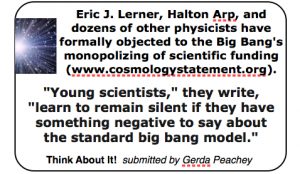 As indicated in the ad, the sentence quoted here can be found at <http://blog.lege.net/cosmology/cosmologystatement_org.html>.
As indicated in the ad, the sentence quoted here can be found at <http://blog.lege.net/cosmology/cosmologystatement_org.html>.
The statement also includes this forceful wording regarding the dominance of the “Big Bang” in current cosmology: “The big bang today relies on a growing number of hypothetical entities, things that we have never observed — inflation, dark matter and dark energy are the most prominent examples. Without them, there would be a fatal contradiction between the observations made by astronomers and the predictions of the big bang theory. In no other field of physics would this continual recourse to new hypothetical objects be accepted as a way of bridging the gap between theory and observation. It would, at least, raise serious questions about the validity of the underlying theory. . . . What is more, the big bang theory can boast of no quantitative predictions that have subsequently been validated by observation. The successes claimed by the theory’s supporters consist of its ability to retrospectively fit observations with a steadily increasing array of adjustable parameters, just as the old Earth-centered cosmology of Ptolemy needed layer upon layer of epicycles.”
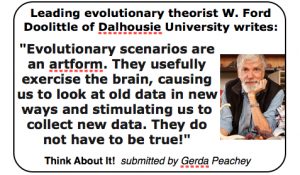 W. Ford Doolittle wrote these words as part of his review of a speculative paper on the origin of cells (see Reviewer’s report 1, in Eugene V. Koonin, Tatiana G. Senkevich, and Valerian V. Dolja, “The ancient Virus World and evolution of cells.” Biology Direct 2006, 1:29, <https://biologydirect.biomedcentral.com/articles/10.1186/1745-6150-1-29>).
W. Ford Doolittle wrote these words as part of his review of a speculative paper on the origin of cells (see Reviewer’s report 1, in Eugene V. Koonin, Tatiana G. Senkevich, and Valerian V. Dolja, “The ancient Virus World and evolution of cells.” Biology Direct 2006, 1:29, <https://biologydirect.biomedcentral.com/articles/10.1186/1745-6150-1-29>).
At Doolittle’s comment the paper’s authors bristled and objected: “. . . we do not accept that ‘evolutionary scenarios are an artform’ but rather contend that this is a distinct and important area of research within the general domain of historical sciences, such as evolutionary biology and cosmology.” They then embarked on a discussion of Popperian falsification. The whole interaction is well worth reading!
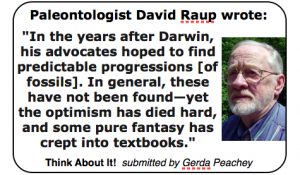
David M. Raup (PhD, Harvard) was Director of the Field Museum of the University of Chicago. This quote is from his article “Evolution and the Fossil Record.” Science 213:289, July 17, 1981.
 A leading Christian apologist of the 20th century, C. S. Lewis wrote these words in a 1951 letter to his friend Bernard Acworth, a leader in the (U.K.) Evolution Protest Movement.
A leading Christian apologist of the 20th century, C. S. Lewis wrote these words in a 1951 letter to his friend Bernard Acworth, a leader in the (U.K.) Evolution Protest Movement.
Just prior to the words quoted, Lewis had written: “I have read nearly the whole of Evolution [probably Acworth’s unpublished “The Lie of Evolution”] and am glad you sent it. I must confess it has shaken me: not in my belief in evolution, which was of the vaguest and most intermittent kind, but in my belief that the question was wholly unimportant. I wish I were younger.”
For a balanced treatment of Lewis’s approach to evolution, see Gary B. Ferngren and Ronald L. Numbers, “C. S. Lewis on Creation and Evolution: The Acworth Letters, 1944-1960.” Perspectives on Science and Christian Faith 48(1):28-33, March 1996. <http://www.asa3.org/ASA/PSCF/1996/PSCF3-96Ferngren.html>

David Berlinski, a secular Jew, is an example of a non-Christian, non-creationist who is involved in the Intelligent Design Movement. He appeared in the Ben Stein movie Expelled: No Intelligence Allowed.
For details on the historical connection between Darwin and Hitler, see Richard Weikart, From Darwin to Hitler: Evolutionary Ethics, Eugenics, and Racism in Germany. New York: Palgrave Macmillan, 2004. An extract from that book is available here.
